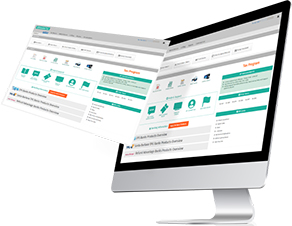Understanding Federal Disaster Declarations
Natural disasters create complex tax situations that require specialized knowledge and quick action. As extreme weather events become more frequent and severe, tax professionals must understand disaster tax relief provisions to serve affected clients effectively while maintaining compliance with rapidly changing regulations.
This comprehensive guide covers everything tax preparers need to know about disaster tax relief, from understanding federal declarations to implementing emergency procedures that keep your practice operational during crisis situations.
How Disaster Declarations Affect Tax Relief
Federal disaster declarations trigger specific tax relief provisions that can significantly benefit affected taxpayers. The IRS automatically provides relief for taxpayers in federally declared disaster areas, but understanding the scope and limitations of this relief is crucial for proper client service.
Major disasters typically receive broader relief than emergency declarations. Presidential disaster declarations under the Stafford Act provide the most comprehensive tax relief, including filing extensions, penalty abatements, and special casualty loss provisions.
The IRS publishes disaster relief announcements on their website within days of federal declarations. These announcements specify affected counties, available relief measures, and new deadlines that replace normal filing requirements.
Monitor disaster declarations regularly during peak weather seasons. Hurricane season runs from June through November, while wildfire season typically peaks from May through October in Western states. Tornado season affects the Midwest primarily from March through June.
Geographic Disaster Patterns
Different regions face predictable disaster patterns that tax preparers should anticipate. Gulf Coast states regularly experience hurricanes that trigger widespread tax relief. California faces annual wildfire seasons that affect large geographic areas and thousands of taxpayers.
Common Regional Disaster Patterns: • Gulf Coast states: Hurricane season June-November with potential for widespread flooding • Western states: Wildfire season May-October affecting rural and suburban communities
• Midwest: Tornado season March-June with severe storm systems causing localized damage • Northeast: Winter storms and flooding with seasonal infrastructure impacts • Southeast: Hurricane impacts plus severe thunderstorms and occasional winter weather events
Earthquake zones require special attention because seismic events can occur without seasonal patterns. California, Alaska, and parts of the central United States face earthquake risks that can trigger sudden disaster declarations.
Understanding your regional patterns helps you prepare clients proactively and maintain disaster response capabilities when emergencies occur.
Filing Extensions and Deadline Relief
Automatic Extensions for Disaster Areas
Taxpayers in federally declared disaster areas receive automatic extensions without filing additional forms or requests. These extensions typically cover income tax returns, estimated tax payments, and various business filings that fall due during the relief period.
Extension periods vary by disaster severity and recovery needs. Minor disasters might receive 30-60 day extensions, while major catastrophes can receive 180 days or more. Hurricane Katrina victims received extensions lasting over a year for some tax obligations.
The IRS publishes specific deadline information for each disaster declaration. New deadlines apply to all tax obligations that would normally be due during the covered period, not just the immediate filing deadline affected by the disaster.
Clients outside declared disaster areas don’t receive automatic extensions, even if they’re affected by the same weather event. Geographic boundaries for disaster relief follow county lines as specified in federal declarations.
Special Provisions for Business Taxpayers
Business taxpayers in disaster areas receive additional relief provisions beyond individual tax extensions. Employment tax deposits, quarterly filings, and annual returns may all receive extended deadlines.
Payroll tax relief helps businesses maintain operations when banking systems are disrupted or employees are displaced. The IRS may waive failure-to-deposit penalties for reasonable cause related to disaster impacts.
Employee benefit plan filings often receive disaster extensions because plan administrators may be located in affected areas or lack access to necessary records for timely filing.
UltimateTax’s comprehensive pricing structure includes unlimited e-filing capabilities that help you process disaster-related extensions and amended returns efficiently when clients need fast service.
Casualty Loss Provisions
Calculating Disaster-Related Losses
Casualty losses from federally declared disasters receive special tax treatment that can provide significant tax benefits. Disaster victims can elect to claim losses on either the current year return or the prior year return, whichever provides better tax benefits.
The election to claim losses on the prior year return often provides faster refunds because amended returns can be processed immediately rather than waiting for the next filing season. This cash flow advantage helps disaster victims with immediate recovery needs.
Calculate casualty losses using Form 4684, which requires determining fair market value before and after the disaster. Professional appraisals may be necessary for significant losses, but the IRS accepts reasonable estimates based on repair costs and other evidence.
Insurance reimbursements reduce deductible casualty losses, but victims can claim losses before insurance settlements are finalized. If insurance later covers previously claimed losses, victims must report the insurance recovery as income in the year received.
Documentation Requirements
Proper documentation is crucial for casualty loss claims because the IRS scrutinizes these deductions carefully. Disaster victims should photograph damaged property immediately after the event and maintain detailed records throughout the recovery process.
Insurance claims provide important documentation even when coverage is inadequate. Claims adjusters’ reports, damage estimates, and settlement correspondence all support casualty loss calculations.
Repair and replacement costs help establish fair market value losses when professional appraisals aren’t available. Contractors’ estimates, actual repair bills, and receipts for temporary repairs all provide acceptable documentation.
Essential Casualty Loss Documentation: • Before and after photographs of all damaged property • Insurance claims, adjusters’ reports, and settlement documentation • Professional appraisals or contractors’ damage estimates • Receipts for emergency repairs and temporary living expenses • Records of federal disaster assistance received
Emergency Tax Practice Procedures
Maintaining Client Services During Disasters
Natural disasters can disrupt tax practices just when clients need services most. Develop emergency procedures that maintain client communication and service capabilities when normal operations are impossible.
Cloud-based tax software provides essential continuity when office facilities are damaged or inaccessible. Remote access capabilities allow you to serve clients from any location with internet connectivity.
Establish alternative communication methods before disasters occur. Cell phone networks often remain operational when landlines fail. Email and text messaging can reach clients when phone calls aren’t possible.
Create emergency contact lists that include key clients, staff members, and professional service providers. Store these lists electronically and offline so they’re accessible regardless of technology failures.
Data Protection and Backup Systems
Client tax records require special protection because they contain sensitive personal and financial information. Develop comprehensive backup systems that protect data from physical disasters and maintain confidentiality during recovery operations.
Automated cloud backups provide the best protection for most practices. Daily backups to secure servers ensure current client information remains accessible even when office systems are completely destroyed.
Test backup systems regularly to ensure data can be restored quickly and completely. Schedule quarterly restoration tests using non-critical data to verify backup integrity without risking active client files.
Physical document storage requires off-site backup for essential records. Safety deposit boxes or secure storage facilities protect original documents that can’t be recreated electronically.
State-Specific Disaster Considerations
Multi-State Disaster Impacts
Large weather systems often affect multiple states simultaneously, creating complex compliance situations for tax preparers serving clients across state lines. Each state may provide different disaster relief provisions that don’t align with federal declarations.
Some states provide disaster relief for events that don’t receive federal declarations. State-only relief typically offers limited benefits compared to federal provisions, but can still provide valuable assistance to affected taxpayers.
Monitor both federal and state disaster declarations for all states where you serve clients. State revenue agencies usually publish disaster relief information on their websites, but notification timing and detail levels vary significantly.
Multi-state businesses face particular complexity when disasters affect operations in some states but not others. Apportionment calculations and nexus requirements may need adjustment based on disaster impacts.
Regional Preparedness Strategies
Tax preparers in disaster-prone regions should develop specialized expertise in disaster tax relief provisions. This knowledge becomes a competitive advantage when serving clients who need expert guidance during crisis situations.
Build relationships with insurance agents, contractors, and other professionals who serve disaster victims. These relationships provide referral opportunities and help you understand the full scope of client recovery needs.
The IRS provides comprehensive disaster tax relief guidance that tax professionals should review regularly, especially during peak weather seasons in their regions.
Consider offering disaster tax relief as a specialized service area. Market your expertise proactively during calm periods so affected clients know where to find help when disasters occur.
Technology Solutions for Disaster Response
Remote Service Capabilities
Modern tax preparation requires technology solutions that function during emergency situations. Cloud-based systems provide essential continuity when traditional office operations are disrupted by weather events.
Mobile capabilities allow you to serve clients from temporary locations while maintaining security and professional standards. Tablet computers with secure internet connections can process returns from hotels, community centers, or other temporary work locations.
UltimateTax’s professional tax software includes both desktop and online versions, providing flexibility when office access is limited or impossible during disaster recovery periods.
Establish relationships with mobile internet providers before disasters occur. Satellite internet services and cellular hotspots provide backup connectivity when traditional broadband services are disrupted.
Client Communication Systems
Effective communication becomes critical when clients face emergency situations that affect their tax obligations. Develop multiple communication channels that remain operational during various disaster scenarios.
Email lists allow you to communicate with many clients simultaneously about disaster relief availability, deadline changes, and service modifications. Automated email systems can send updates even when you can’t access your office.
Social media platforms provide another communication channel that often remains operational during disasters. Facebook and Twitter can reach clients quickly with urgent updates about disaster relief provisions.
Text messaging services work well for urgent client communications because most people check text messages more frequently than email during crisis situations.
Compliance and Professional Responsibilities
Professional Standards During Emergencies
Tax preparers maintain professional responsibilities even during emergency situations. Understanding how disaster situations affect compliance requirements helps you serve clients properly while protecting your professional standing.
The AICPA’s professional standards continue to apply during disaster situations, but reasonable cause exceptions may apply when disasters prevent normal compliance procedures.
Document disaster impacts on your practice and client service capabilities. This documentation supports reasonable cause arguments if professional compliance issues arise from disaster-related service disruptions.
Maintain client confidentiality even when working from temporary locations or using alternative communication methods. Disaster situations don’t reduce confidentiality obligations or security requirements.
Staying Current with Relief Provisions
Disaster tax relief provisions change frequently as new weather events occur and recovery needs evolve. Successful tax preparers develop systems for staying current with relief announcements and regulatory changes.
Subscribe to IRS email updates for disaster relief announcements. The IRS typically publishes relief information within 24-48 hours of federal disaster declarations.
Join professional organizations that provide disaster relief updates to members. State CPA societies and the National Association of Tax Professionals often provide timely updates about disaster relief provisions.
Monitor news sources in areas you serve for weather events that might trigger disaster declarations. Early awareness helps you prepare client communications and service modifications before official announcements.
Frequently Asked Questions
How do I know if my clients qualify for disaster tax relief?
Clients qualify for disaster tax relief when they’re located in federally declared disaster areas. Check IRS.gov for current disaster declarations, which specify affected counties and available relief measures including filing extensions and penalty abatements. Relief is automatic for taxpayers in declared areas.
What filing extensions are available for disaster-affected taxpayers?
Disaster relief typically includes extensions for filing tax returns, paying taxes, and making estimated payments. Extensions vary by disaster but commonly provide 60-180 additional days beyond normal deadlines. The IRS publishes specific new deadlines for each disaster declaration.
How do I claim casualty losses from weather disasters?
Casualty losses from federally declared disasters can be claimed on the current or prior year return for faster refunds. Use Form 4684 to calculate losses, considering insurance reimbursements and fair market value before and after the disaster. Professional documentation is essential.
What records should disaster victims maintain for tax purposes?
Maintain photos of damaged property, insurance claims, repair receipts, temporary living expenses, and federal disaster assistance records. Document property values before and after disasters for accurate casualty loss calculations. Store records in multiple locations for protection.
Can clients amend prior year returns for disaster losses?
Yes, disaster victims can elect to claim casualty losses on the prior year return by filing an amended return or by attaching a statement to the current year return making the election. This often provides faster refunds to help with immediate recovery needs.
What emergency procedures should tax preparers follow during disasters?
Establish client communication protocols, secure backup systems for essential records, develop mobile capabilities for continued service, and stay informed about disaster declarations affecting your service area. Create written emergency procedures before disasters occur.
Prepare your practice for disaster tax relief situations with UltimateTax’s comprehensive tax software solutions. Our cloud-based and desktop options ensure you can serve clients during emergencies, while unlimited e-filing helps process disaster-related returns efficiently.
Contact UltimateTax today to learn how our professional tax software can help you provide expert disaster tax relief services to clients when they need help most.







